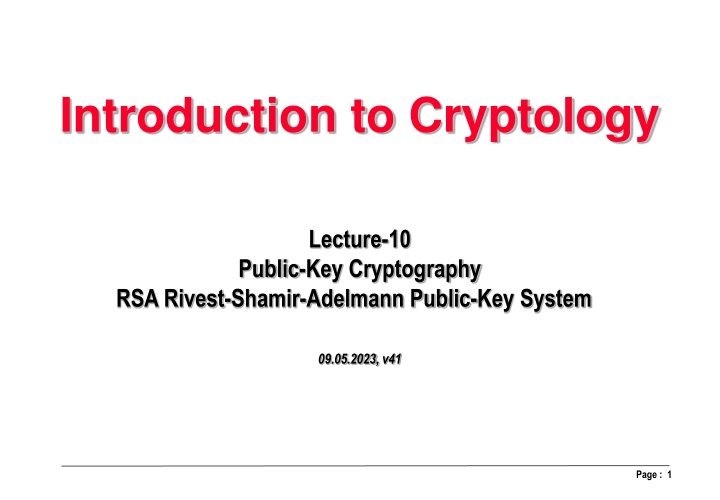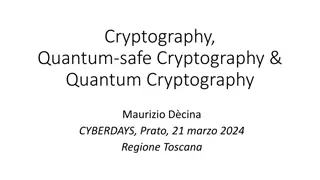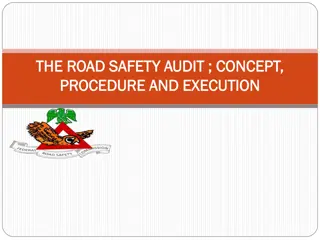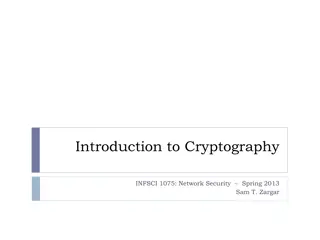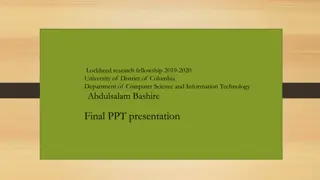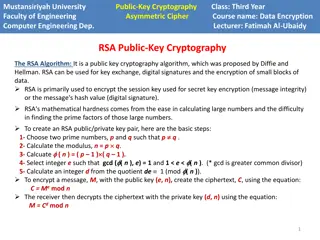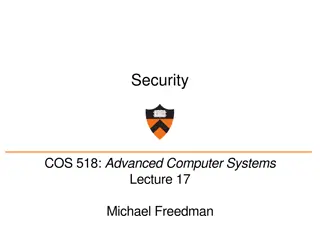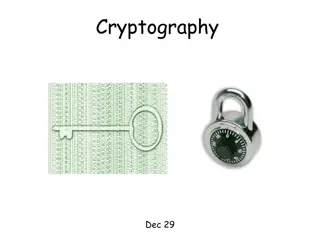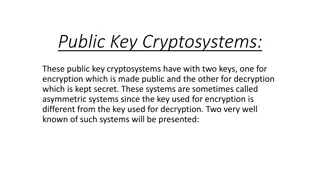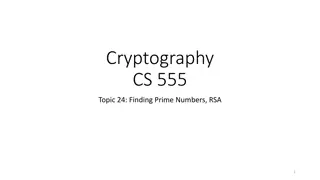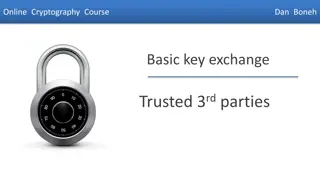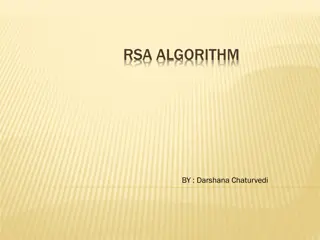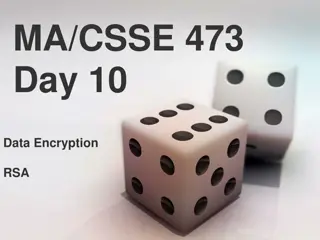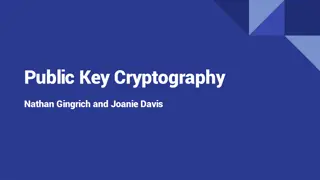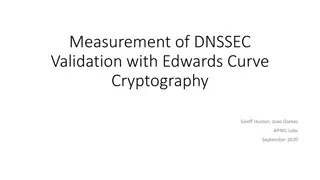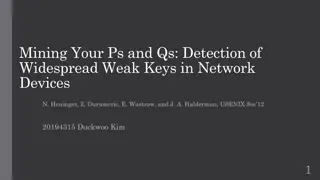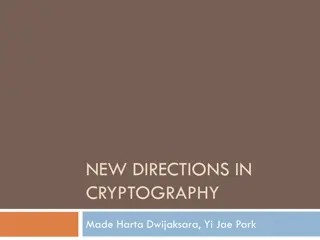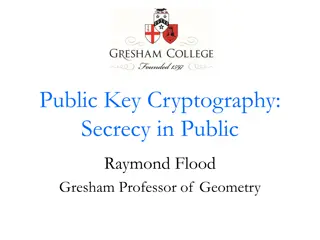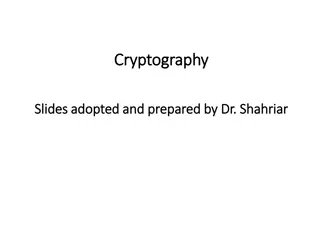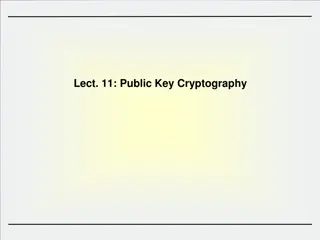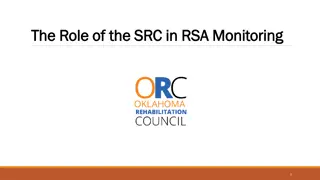Introduction to RSA Public-Key Cryptography
Delve into the intricacies of RSA public-key cryptography system, exploring its historical overview, encryption mechanism, security considerations, and implementation using Rivest-Shamir-Adleman algorithm. Understand the basics of public-key secrecy, conventional crypto-systems, and the significance of Euler's theorem in RSA security. Dive deeper into RSA lock functionality, exponentiation in Zm ring, encryption and decryption processes, as well as security implications involving large composite numbers and prime factorization challenges.
Download Presentation

Please find below an Image/Link to download the presentation.
The content on the website is provided AS IS for your information and personal use only. It may not be sold, licensed, or shared on other websites without obtaining consent from the author.If you encounter any issues during the download, it is possible that the publisher has removed the file from their server.
You are allowed to download the files provided on this website for personal or commercial use, subject to the condition that they are used lawfully. All files are the property of their respective owners.
The content on the website is provided AS IS for your information and personal use only. It may not be sold, licensed, or shared on other websites without obtaining consent from the author.
E N D
Presentation Transcript
Introduction to Cryptology Lecture-10 Public-Key Cryptography RSA Rivest-Shamir-Adelmann Public-Key System 09.05.2023, v41 Page : 1
Lecture Outlines Historical Overview ! RSA Public-Key Encryption System RSA Public-Key Signature System RSA Security considerations Page : 2
The Target of Public Key Cryptography Ciphering Receiver De-Ciphering Sender Y = E (Z,X) E ( Z,X ) X X D ( Z,Y ) Message Message Channel Z Z Secret Key Channel Public-Register To replace that secret key- agreement completely Secret Key = Z Page : 3
Basic Public Key Secrecy System (RSA system1978) RSA: Rivest-Shamir-Adleman, MIT, USA (Mechanical Lock simulation: user A sends a message to B) User A User B Public register Ko= Kc-1 Close Kc Kc open ( )Kc(mod m) M MKc.Ko= M Ko MKc (MKc)Ko Page : 4
Conventional Public-Key Crypto-system (using asymmetric keys) Sender Receiver Y = E (Zp,X) X X E ( Zp,X ) D ( Zs,Y ) Message Message Channel Zp Zs Secret-Key Zs Public-Key Zp Public-Key Zp Public Directory Z.. Zp Z... Page : 5
Public-Key Secrecy System RSA 1978 (Rivest Shamir Adelmann) MIT, USA !! K-close K-open Trap-door One Way Function ! RSA key idea to implement such a lock: is based mainly on Euler theorem and on the two unproved claims: 1. Euler function for any integer m is only computable if the factorization of m is known. e1 e2e3et 1 1 (m) = m ( 1 - ) ( 1 - ) form = p1 p2 p3 .... pt P1 P2 2. Factorization is considered as computationally hard and unsolved problem Page : 6
RSA-Lock (Hiding Function) Uses Exponentiation in the Ring Zm Where m = p.q , p and q are two large secret primes Open key E M E (mod m) ENCRYPTION D Secret key D ( ) M E (mod m) DECRYPTION ( M E)D mod (m) = M E. D mod (m)= M To get M, the following should hold: E . D = 1 or D = E-1in the exponent That is E and D should be invertible modulo (m) ! Or gcd (E, (m) ) =1 Security Considerations: m is a large composite (m=p q), p and qare two large secret primes. To break the system (m) is required to compute D = E-1modulo (m). However, (m) can only be computed if p and q are known.Therefore, the system can only be broken if and only if: m can be factored OR (m) can be found somehow without factorization! Page : 7
Design Template for RSA Public Key Secrecy System Open directory USER A: USER B: User A Na Ea Na= pa. qaopen modulus of A pa. qatow secret large primes (Na) = (pa-1).(qa-1) Nb= pb. qbopen modulus of B pb. qbtow secret large primes (Nb) = (pb-1).(qb-1) User B Nb Eb Ea= open Encryption key of A Da= Ea-1 [mod (Na) ] Condition: gcd [Ea, (Na) ] = 1 Eb= open Encryption key of B Db= Eb-1 [mod (Nb) ] Condition: gcd [ Eb, (Nb) ] = 1 Number of possible keys = [ (Na)] Number of possible keys = [ (Nb)] A sends Message M to B: Y= M mod Nb (Encrypt) Db EbDb Eb = M mod Nb =M (Decrypt) Y Page : 8
Security of RSA Public Key System Is Exponentiation y = a x - Theoretically not (no proof that (m) is not computable if we do not know p and q !!) - Practically (m) computation is dificult if : m is a product of two large strong primes! in Zm a One-Way Function ? RSA system can be broken by: 1. Factoring m = p . q 2. Computing (m) somehow without factoring m. However, factorization is computationally equivalent to computing Euler function (m) Proof: (m) = (p -1)(q -1) = m - p - q + 1 s = (p + q) = m - (m) + 1 m = p . q p or q = ( s s2- 4 m ) / 2 Page : 9
RSA Security and State of the Art in Factorization No consistent and reliable answer (only claims according to the state of the art!): In general: Factorization Complexity is O ( m) That is, if the modulus m is an integer in the range of 2nbits To factor m, a computational complexity proportional to 2 n/2 is required. ! There are still ongoing secret and open research on factorization! ! Therefore, there are published results and unpublished results! In the public literature; In number theory, the general number field sieve (GNFS) is the most efficient classical algorithm known for factoring integers larger than 10100. Heuristically, its complexity for factoring an integer n (consisting of log2n + 1 bits) is of the form: Factorization is a business of mathematicians ! 10 Page : 10
Designing adequate and good RSA cryptosystem 1. How to choose large primes p,q for the modulus m=pq? Select primes randomly by using miller test or Pocklington theorem or other refined versions for generating primes. 2. Relationship between p and q - Difference |p-q| should be neither too small nor too large. - gcd(p-1, q-1) should not be large. - Both p-1 and q-1 should contain large prime factors (strong primes). The ideal case is: q, p should be strong primes - such that (p 1)/2 and (q-1)/2 are primes. Examples: 83 = 2x41 + 1 , 107= 2x53 + 1 3. Selecting e and d ? - Neither d nor e should be small. - d should not be smaller than n1/4. (For d < n1/4a polynomial time algorithm may determine d). Many other considerations and refinements may appear according to the current state of the open research! Page : 11
Public-Key Signature Scheme Signing Process Verification Process Message M to be signed Public Directory EaVerification Key for A Message Encrypting by secret- key Da Public-Key encryption Decrypting signature by Ea And check if decryption reveals M Reject Message M Signature Sa Encrypted M by Da Signature Sa of user A Signed Message Accept Page : 12
Design Template for the RSA Public Key Signature System Open directory USER A: USER B: User A Na Ea Na= pa. qaopen modulus of A pa. qatwo secret large primes (Na) = (pa-1).(qa-1) Nb= pb. qbopen modulus of B pb. qbtwosecret large primes (Nb) = (pb-1).(qb-1) User B Nb Eb Ea= open Encryption key of A Da= Ea-1 [mod (Na) ] Eb= open Encryption key of B Db= Eb-1 [mod (Nb) ] gcd [Ea, (Na) ] = 1 gcd [ Eb, (Nb) ] = 1 A signs Document M for B: Da DaEa Ea (M,S) = S mod Na M = M mod Na=M (Verify M =M)? If M = M then the signature is true Signed MessageS Page : 13
Example: Construct RSA secrecy and signature system using the two prime pairs 11, 5 and 3,11. Encrypt the message M=2 sent to user B. Let B signs M and send his signature back to A. Solution: Open directory USER A: Na= 11 x 5 open modulus of A pa. qatwo secret large primes (Na) = (pa-1).(qa-1) = (11-1)(5-1) = 40 USER B: User A 55 7 Nb= 3. 11 open modulus of B pb. qbtwo secret large primes (Nb) = (pb-1).(qb-1) =20 User B 33 3 3 = Eb=open Encryption key of B gcd [ Eb, (Nb) ] = 1 gcd(3,20)=1 7= Ea= open Encryption key of A gcd [Ea, (Na) ] = 1 gcd(7,40)=1 [mod (Nb) ] =7 Db= Eb-1 Da= 7-1 [mod 40) ] =23 A sends Message M=5 to B: 3 7 Y = 26 mod 33 = 5 = M (Decrypt) Y = 5 mod 33= 26 (A Encrypts M) 26 Security Gap: Notice that anybody can decrypt S to disclose M! Any other solution? S = 14 M =143 mod 33 = 5 = M (Verify) S= 57mod 33 = 14 (B signes M) Page : 14
Live Example: sending a secret document M from B to A encrypted as Ybaexpecting B to sign it back securely. Then A decrypts it and encrypts it to B as Yaband signs Yabto B. Solution: USER A: Na= 13 x 11 open modulus of A pa. qatwo secret large primes (Na) = (pa-1).(qa-1) = (13-1)(11-1) = 120 Open directory USER B: User A 143 43 Nb= 7. 11 open modulus of B pb. qbtwo secret large primes (Nb) = (pb-1).(qb-1) =60 User B 77 17 17 = open Encryption key of B gcd [ Eb, (Nb) ] = 1 Gcd(3,20)=1 43= open Encryption key of A gcd [Ea, (Na) ] = 1 gcd(43,120)=1 [mod (Nb) ] =-7=53 Db= Eb-1 Da= 43-1mod 120=-53=-53+120= 67 B encrypts Message M=24 to A: A decrypts Yba: Yba= 41 2 Yba= 2443mod 143 = 41 (B Encrypts M) B verifies: M=YDa= 4167mod 143 = 24 (Decrypt) A encrypts M back to B as Yabthen signs Yab.: 1 Yab=MEb mod 77= 2417mod 77=40 S = (Yab)Damod 143 S = (40)67= 105 (Signing the encrypted M to B) 10543mod 143 = 40= Yab M= 4053mod 77 = 24 (B checks) 40, S=105 4 3 (Signature) Page : 15
